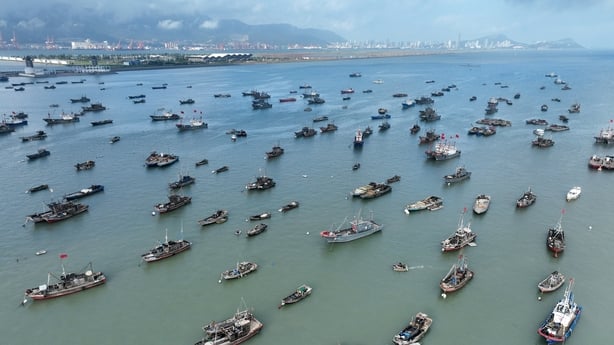Flights were cancelled and tens of thousands of people were advised to evacuate their homes as powerful typhoon Khanun approached Japan's southern Okinawa island chain, threatening torrential rains and high winds through to Thursday.
Residents in the popular tourist destination, which is around 1,600km southwest of Tokyo, were advised to evacuate as the storm, with winds exceeding 200km/h, slowly moved northwest.
In Okinawa's capital Naha, the airport was closed and all flights - amounting to about 900 - cancelled, TV Asahi said.
At least 20,000 people were also affected by evacuation advisories in the city, officials said.
Wind and rain were picking up, with the storm expected to escalate by tomorrow.
The storm's path remained unpredictable, with some meteorologists saying it could affect eastern China later this week, while public broadcaster NHK said it could turn east, potentially affecting Japan's main islands.
The storm is hitting during the peak summer tourist season, which this year has seen the number of visitors return to pre-pandemic levels.
Okinawa is frequently hit by typhoons, but usually later in the year.
Television footage showed most streets in Naha deserted as rain pounded the pavement.
At least 180mm of rain was expected to fall by midday local time tomorrow, when the storm was likely to brush closest to the area, NHK public television said.
Okinawa is host to the bulk of US forces in Japan, and Kadena Air Base - one of the largest installations - warned personnel to take all necessary precautions.
Severe weather affected other parts of Japan yesterday, with a thunderstorm pounding Tokyo and surrounding areas, leaving some 15,000 households without power at one point.

In China, Beijing and nearby cities stepped up rescue and recovery work after rains and widespread flooding brought by remnants of Typhoon Doksuri disrupted utility services and food supplies and claimed at least 20 lives.
Beijing's Fangshan district said it would deploy helicopters to drop off food, drinking water and emergency supplies to villages in mountainous areas that have been cut off.
In nearby Tianjin, where rain has become intermittent, 35,000 people have been evacuated from homes and the local government fortified river banks and stepped up the inspection and repairs of power, water and communications lines.
The death toll in Beijing rose to 11 with 13 people still missing, while in neighbouring Hebei province, nine people died and six were missing.
President Xi Jinping demanded thorough search and rescue efforts for those missing or trapped, instructing authorities to minimise casualties and restore living conditions to normal as soon as possible, state media reported.
Doksuri, one of the strongest storms to hit China in years, weakened as it rolled inland and dumped non-stop precipitation in northern cities over a few days. Authorities have warned risks of further floods and other geological disasters remained.
Rivers have swollen to dangerous levels, prompting Beijing to use a flood storage reservoir for the first time since it was built 25 years ago. As of last night, China's capital city had sealed off over 100 mountain roads and evacuated more than 52,000 people from their homes.
Several subway lines in the capital, including trains in western suburbs, were suspended today.
Nearly 400 flights were cancelled and hundreds delayed at Beijing's two airports, tracker app Flight Master showed.

